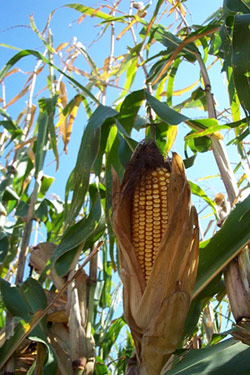Ethanol in the news again…
November 29th, 2005

I must confess I don’t know a lot about ethanol, other than Pawlenty is utilizing it to tout himself as the “environmental Governor” (urp), and from the MAPP meetings I know that every time an ethanol plant is built there’s an issue about electrical service to the site, the load is so large that it alters load shapes for the area and there’s new infrastructure necessary. Today it’s in the STrib again:
Once just a kernel of innovation, ethanol industry now popping
Corn-based fuel is becoming the United States’ front-runner alternative to imported oil.
In the article, there’s info about fueling the ethanol making process:
A cooperative in Little Falls, Minn., is spending $8 million so it can make ethanol by burning scrap wood instead of more expensive natural gas…
The Central Minnesota Ethanol Co-op in Little Falls is building huge bins to hold 1,200 tons of timber cuttings, storm-damaged trees and scrap wood that will replace natural gas as its energy source, said Kerry Nixon, the plant’s general manager. He contends the plant will burn “waste energy” and create three units of energy for every unit of fossil fuels burned. The excess steam will be harnessed to create a megawatt of electricity, and a new thermal oxidizer will burn most of the pollutants, he said.
Can someone explain why they can’t use ethanol as the fuel rather than natural gas?
Here’s another today from the Mankato Free Press: Flexible Fuel
And what is BP up to? This is too vague…
BP plans alternative energy firm

December 3rd, 2005 at 8:09 pm
“Can someone explain why they can’t use ethanol as the fuel rather than natural gas?”
Ms Overland,
I once asked someone in the corn ethanol business that exact question. The answer he gave was, “If we did that, we wouldn’t have any ethanol left to sell.”
Of course that answer tells you all you need to know about whether growing corn and turning it into ethanol returns more fuel than its production consumes.
I say fuel because energy and fuel are not the same. All fuel is energy, but not all energy is in the form of a useful fuel.
Most studies show that making corn ethanol does actually return more energy than it uses, however, the ethanol industry and their lobbyists have yet to show making corn ethanol returns more FUEL than its production consumes.
My guess is that it will be a long time before they do that since making corn ethanol is entirely dependent on consuming fossil fuels, and in fact, corn ethanol’s dependency on fossil fuels is actually growing instead of decreasing.
Our corn farmers could not grow massive amounts of corn without applying massive amounts of nitrogen fertilizers. But guess what? Almost all nitrogen fertilizers are now made from natural gas. And what’s even worse is that because domestic supplies of natural gas cannot keep up with demand, more and more of that fertilizer is made overseas from foreign natural gas and imported into the U.S. I’ve even seen estimates by experts in the ag business who think that within five years almost 100% of the nitrogen fertilizers our farmers use will have to be imported.
That means of course that the production of corn ethanol will be dependent on a foreign fossil fuel — natural gas. How much sense does it make to trade our admittedly bad dependence on foreign oil for an equally ill-advised dependence on foreign gas?
From diesel fuel to natural gas, making corn ethanol consumes more FUEL than it can return, and fuel is what counts — not energy.
Unfortunately, the excess energy from the production of corn ethanol is locked inside a waste product of fermentation and distillation called dried distillerâ??s grain (DDG) to the tune of about 9600 Btu/lb. At micro-scales of a handful of ethanol plants in each state, DDG has uses as cattle feed. But at macro-scales with hundreds of ethanol plants, our livestock farmers could not use all the DDG that would pile up around ethanol plants. If we ever went to large scale production of corn ethanol, the ethanol plants would soon resemble old coalmines with their huge slag heaps, only the slag heaps around ethanol plants would be piles of waste DDG holding the excess energy from corn ethanol that no one would want, hardly anyone could use, and no one could afford to haul away.
Ethanol may have some kind of role in our energy future, but it’s not likely to be ethanol made from corn. Brazil is on the way to using ethanol, but their ethanol is made from sugar cane not corn.
It is more efficient to make ethanol from sugar cane rather than corn starch, and Brazil has the huge advantage of using dirt cheap manual labor to harvest their cane instead of farmers driving tractors and corn pickers that cost hundreds of thousands of dollars and each burning 20 gallons or more of diesel fuel per hour.
December 4th, 2005 at 8:25 pm
Ms Overland,
I’ve always kept track of the amount of fuel I buy and my mileage since owning my first car in 1967. As ethanol blended fuels came onto the market, I noticed I always seemed to get worse gas mileage when using them. Strange as it may seem, my experience is that using an ethanol-blended fuel not only reduces my fuel mileage, but also going against intuition, saves no gasoline.
I now drive a small pickup truck that gets about 32 mpg when I burn gasoline on a highway at a steady speed of about 65 mph. When I burn E10 (90% gasoline and 10% ethanol) for the same type trip, the mileage drops to about 29 mpg. That means on a trip of 320 miles I would burn 10 gallons of gasoline, or 11 gallons of E10.
But hereâ??s the counterintuitive part: When I burn E10, 90% of that is gasoline. Guess how much 90% of 11 gallons is â?? just a fraction less than 10 gallons. Whether I burn gasoline or E10, my truck burns 10 gallons of gasoline to go 320 miles. Unfortunately when I use E10, I have to buy and pay for 11 gallons of fuel. It should be obvious why I long ago decided to use E10 only when nothing else is available.
Of course my experience could be an anomaly, so I started looking for other evidence. I asked around and found that others who keep track of their fuel economy have had similar results. Then I found an official source that confirms my expereince and which is indeed compelling:
The United States Department of Transportation (USDOT) keeps data on the fuel burned and miles driven in each of the 50 state. Using their data I computed the fuel economy figures for Minnesota and Wisconsin. The two states are similar. Both are in are Upper Midwest and have similar weather, topography, demographics, and about the same mix of rural and urban population. The only difference that jumps out is that Minnesota mandates all their motor fuel contain at least 10% ethanol, while most fuel sold in Wisconsin is still straight gasoline.
Here is what I found:
— In 2003, Minnesotans used 2.730 billion gallons of ethanol-blended fuels while driving 55.296 billion miles. Minnesotaâ??s average fuel economy was 20.25 mpg.
— In the same year, Wisconsin drivers used 2.570 billion gallons of fuel while driving 59.615 billion miles. Wisconsinâ??s average fuel economy was 23.20 mpg.
Minnesota drivers burned more fuel than their Wisconsin neighbors while driving less distance. In fact, their rate of fuel consumption using E10 was 14% more than the Wisconsin consumption rate using gasoline. Now hereâ??s the real kicker â?? Minnesota actually burned more gasoline at their mileage rate than they would have had they used straight gasoline and their mileage rate equaled Wisconsinâ??s. (90% of their fuel is gasoline. Their rate of consumption is 114% of Wisconsinâ??s. 90% of 114 is more than %100 of 100.)
What Iâ??ve found seems to say that anyone who thinks mandating E10 is going to benefit fuel use in their state should probably go back and rethink that idea. Using the experience in Minnesota compared to its neighbor Wisconsin, the evidence leads to the conclusion that mandating ethanol not only saves no gasoline, but means the drivers in Minnesota have to buy more fuel and spend more money to it.
However, there is one hidden benefit that Minnesota politicians probably wonâ??t want their constituents to know: Since Minnesotans buy and burn 14% more fuel using E10, that means they also pay 14% more in motor fuel taxes. There are probably some Minnesota politicians who are no doubt happy with this hidden â??windfallâ? that increases motor fuel tax revenues.